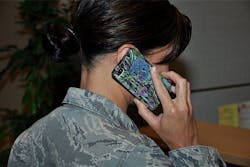DARPA eyes cell phones as continuous health monitor to determine warfighter readiness for duty
Officials of the U.S. Defense Advanced Research Projects Agency (DARPA) in Arlington, Va., will outline the upcoming Warfighter Analytics using Smartphones for Health (WASH) project during briefings from 1:30 to 3:45 p.m. on 16 May 2017 at the DARPA Conference Center, 675 N. Randolph St., in Arlington, Va.
The WASH program will use data from cell phone sensors to conduct passive, continuous, real-time assessment of the warfighter. WASH will extract physiological signals, which may be weak and noisy, from cell phone-based accelerometers, screens, and microphones to determine the health status and identify latent or developing health disorders in warfighters before their missions.
WASH will develop algorithms and techniques to notice deviations in the warfighter’s micro-behaviors that could indicate physiological problems like disease, illness, or injuries.
Related: Wearable electronics adapt to the infantry
DARPA scientists are trying to devise the same kind of health monitoring for human warfighters as are available for many kinds of military electronics, officials say. To determine the readiness of equipment, manufacturers and operators employ sensors and data analytics on device diagnostic data to enable the quick and early identification of weaknesses and possible failures.
This can reduce maintenance costs failure rates, and identify problems before they can compromise missions. No such approach to understanding the condition and mission readiness of the human warfighter, however, even though it might affect the unit as a whole -- especially through conditions such as infectious disease.
Assessing the readiness of the human warfighter today is complex, intrusive, done relatively infrequently, and relies heavily on self-reporting.
Military commanders can determine warfighter readiness only through medical intervention with the help of advanced equipment like electrocardiographs (EKGs) and other specialized medical devices that are too expensive and cumbersome to employ. On the other hand, 92 percent of adults in the U.S. own cell phones, which could be the basis for continuous, passive health and readiness assessment.
Related: Widespread use of wearable technology
DARPA's industry briefings on the WASH program are to familiarize participants with DARPA’s interest determining warfighter health conditions and readiness using mobile health analytics. A formal solicitation for the DARPA WASH program is expected around mid-May.
Register for the DARPA WASH industry briefings online at https://www.schafertmd.com/darpa/i2o/wash/pd/ no later than noon eastern time on 11 May 2017.
Email questions or concerns to DARPA at [email protected]. More information is online at https://www.fbo.gov/spg/ODA/DARPA/CMO/DARPA-SN-17-43/listing.html.
Learn more: search the Aerospace & Defense Buyer's Guide for companies, new products, press releases, and videos
